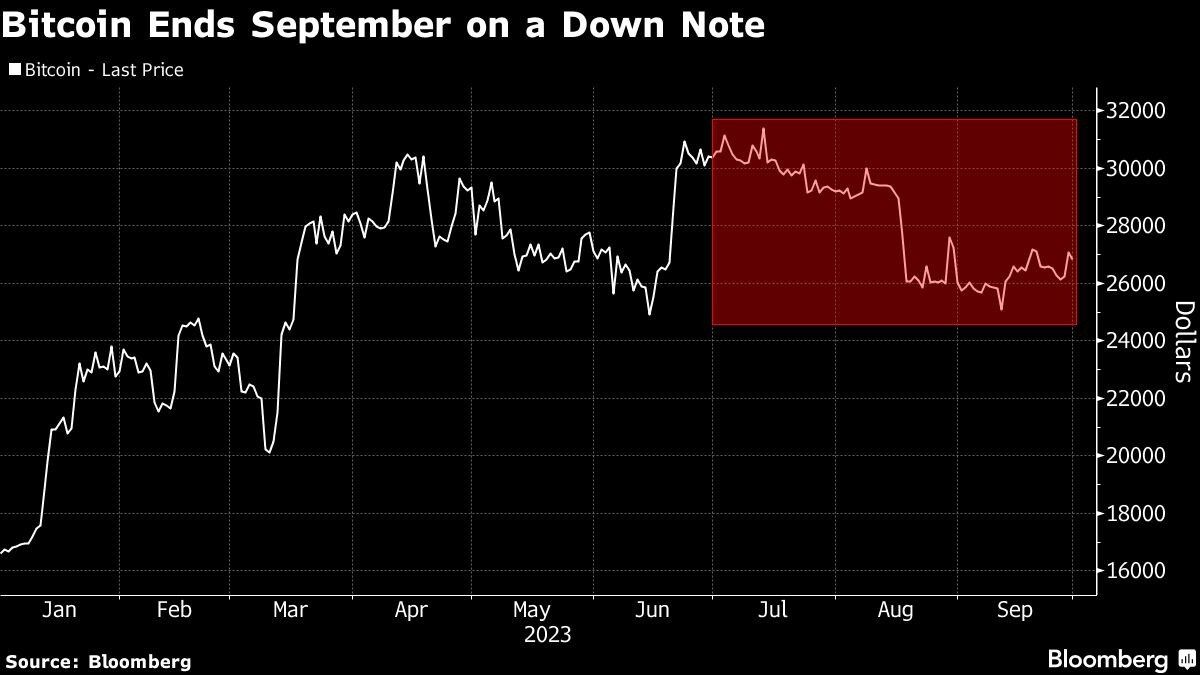
Bitcoin Poised for First Quarterly Decline of the Year
As September draws to a close, Bitcoin is facing a down note as it heads towards its first quarterly decline of this year. The largest cryptocurrency by market value has experienced an 11% drop since June and is currently trading at around $26,970 in New York.
Bitcoin’s performance in the first half of 2023 was impressive, surging by 83% and recovering from a massive 64% plunge experienced in 2022 due to scandals and bankruptcies in the digital asset sector. However, since late in the second quarter, Bitcoin has been trapped in a narrow trading range, primarily due to an uncertain macro outlook.
One factor contributing to this stagnation is the Federal Reserve’s hawkish stance on interest rates. Although the Fed left rates unchanged last week, it indicated that rates would be higher for a longer duration. This has diminished the appeal of riskier assets, including Bitcoin.
According to Hosam Mahmoud, a research analyst at CCData, the Federal Reserve’s stance has heightened investor apprehension, leading to declines in both traditional and digital asset markets. In fact, over the course of nine weeks ending in mid-September, investors withdrew almost half a billion dollars from cryptocurrency products, with Bitcoin comprising 85% of the outflows at $45 million, according to a report by CoinShares.
In addition to these challenges, the delay in decisions on several Bitcoin exchange-traded fund (ETF) proposals by the US Securities and Exchange Commission has also dampened investor sentiment. BlackRock Inc.’s spot Bitcoin ETF proposals, as well as those from Ark 21Shares and GlobalX, were all deferred until January. Peter Tchir, head of macro strategy at Brean Capital, believes that while a Bitcoin ETF would have made a significant impact a few years ago when owning cryptocurrency was more complicated, it may not have the same effect now.
However, amidst these setbacks, some Bitcoin advocates are predicting a potential rally due to the prospects of a US federal government shutdown. They draw comparisons to earlier this year when Bitcoin experienced a 25% jump over a one-month period in response to the regional bank crisis. It is worth noting that the cryptocurrency market is known for its volatility and can experience abrupt shifts in response to various factors.
Will Tamplin, senior analyst at Fairlead Strategies, suggests that there are signs indicating that Bitcoin’s corrective phase may be maturing. He points out that it has cleared the 50-day moving average and reflects improved momentum off the back of oversold conditions.
In conclusion, Bitcoin is facing its first quarterly decline this year, with a drop of about 11% since June. The uncertain macro outlook, the Federal Reserve’s hawkish stance, delays in Bitcoin ETF decisions, and outflows from cryptocurrency products have all contributed to this decline. However, some Bitcoin advocates remain optimistic, pointing to the potential for a rally if a US government shutdown occurs. As always, the cryptocurrency market remains unpredictable, and investors should proceed with caution.






